Top Rankings
Willmar Public School District ranks among the top 20% of public school district in Minnesota for:
Category
Attribute
Diversity
Most diverse schools (Top 1%)
Community Size
Largest student body (number of students) (Top 1%)
For the 2025 school year, there are 6 public high schools serving 1,359 students in Willmar Public School District. This district's average high testing ranking is 3/10, which is in the bottom 50% of public high schools in Minnesota.
Public High Schools in Willmar Public School District have an average math proficiency score of 29% (versus the Minnesota public high school average of 36%), and reading proficiency score of 40% (versus the 51% statewide average).
Public High School in Willmar Public School District have a Graduation Rate of 74%, which is less than the Minnesota average of 83%.
The school with highest graduation rate is Willmar Senior High School, with 82% graduation rate. Read more about public school graduation rate statistics in Minnesota or national school graduation rate statistics.
Minority enrollment is 59% of the student body (majority Hispanic), which is more than the Minnesota public high school average of 37% (majority Hispanic and Black).
Overview
This School District
This State (MN)
# Schools
12 Schools
1,177 Schools
# Students
4,220 Students
310,035 Students
# Teachers
308 Teachers
18,776 Teachers
Student : Teacher Ratio
14:1
14:1
District Rank
Willmar Public School District, which is ranked within the bottom 50% of all 522 school districts in Minnesota (based off of combined math and reading proficiency testing data) for the 2021-2022 school year.
The school district's graduation rate of 76% has increased from 69% over five school years.
Overall District Rank
#353 out of 527 school districts
(Bottom 50%)
(Bottom 50%)
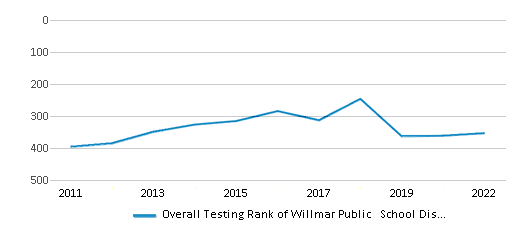
Math Test Scores (% Proficient)
40%
45%
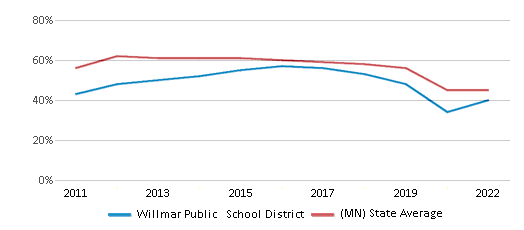
Reading/Language Arts Test Scores (% Proficient)
36%
51%
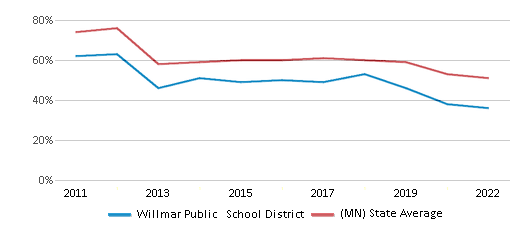
Science Test Scores (% Proficient)
26%
41%

Graduation Rate
76%
84%
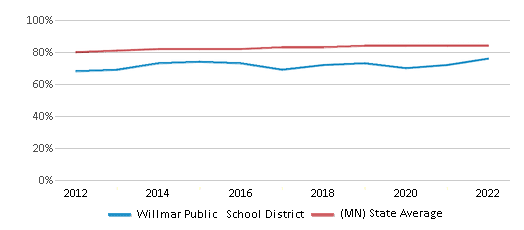
Students by Ethnicity:
Diversity Score
0.67
0.57
# American Indian Students
8 Students
6,364 Students
% American Indian Students
n/a
2%
# Asian Students
164 Students
19,892 Students
% Asian Students
4%
7%
# Hispanic Students
1,855 Students
35,225 Students
% Hispanic Students
44%
11%
# Black Students
633 Students
34,141 Students
% Black Students
15%
11%
# White Students
1,448 Students
196,402 Students
% White Students
34%
63%
# Hawaiian Students
4 Students
317 Students
% Hawaiian Students
n/a
n/a
# Two or more races Students
108 Students
17,694 Students
% of Two or more races Students
3%
6%
Students by Grade:
# Students in PK Grade:
237
229
# Students in K Grade:
304
120
# Students in 1st Grade:
290
204
# Students in 2nd Grade:
290
210
# Students in 3rd Grade:
282
264
# Students in 4th Grade:
289
305
# Students in 5th Grade:
299
384
# Students in 6th Grade:
291
3,144
# Students in 7th Grade:
295
11,219
# Students in 8th Grade:
285
12,649
# Students in 9th Grade:
369
67,716
# Students in 10th Grade:
321
69,634
# Students in 11th Grade:
334
69,942
# Students in 12th Grade:
334
74,015
# Ungraded Students:
-
-
District Revenue and Spending
The revenue/student of $16,804 in this school district is less than the state median of $17,854. The school district revenue/student has stayed relatively flat over four school years.
The school district's spending/student of $16,789 is less than the state median of $18,580. The school district spending/student has stayed relatively flat over four school years.
Total Revenue
$71 MM
$15,547 MM
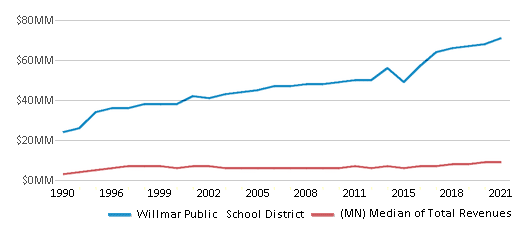
Spending
$71 MM
$16,179 MM
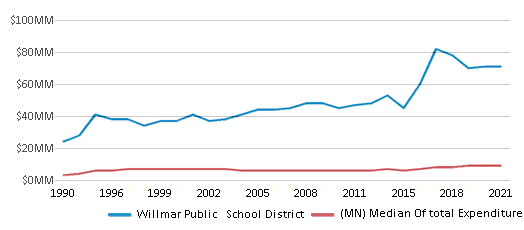
Revenue / Student
$16,804
$17,854

Spending / Student
$16,789
$18,580
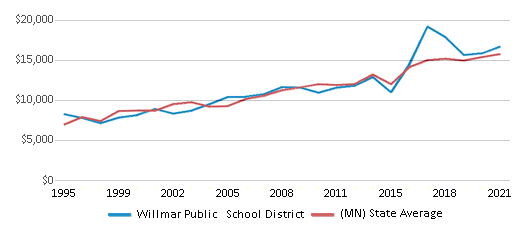
Best Willmar Public School District Public High Schools (2025)
School
(Math and Reading Proficiency)
(Math and Reading Proficiency)
Location
Grades
Students
Rank: #11.
Prairie Lakes Education Center
Alternative School
(Math: <50% | Reading: <50%)
Rank:
Rank:
7/
Top 50%10
1804 Civic Center Dr
Willmar, MN 56201
(320) 214-6696
Willmar, MN 56201
(320) 214-6696
Grades: 4-12
| 26 students
Rank: #22.
Lake Park School
Alternative School
(Math: <50% | Reading: <50% )
Rank:
Rank:
6/
Top 50%10
1804 Civic Center Dr Ne
Willmar, MN 56201
(320) 214-6696
Willmar, MN 56201
(320) 214-6696
Grades: 4-12
| 17 students
Rank: #33.
Willmar Senior High School
(Math: 30% | Reading: 41%)
Rank:
Rank:
3/
Bottom 50%10
2701 30th St Ne
Willmar, MN 56201
(320) 231-8300
Willmar, MN 56201
(320) 231-8300
Grades: 9-12
| 1,218 students
Rank: #44.
Willmar Area Learning Center
Alternative School
(Math: ≤10% | Reading: 20-29%)
Rank:
Rank:
1/
Bottom 50%10
512 8th St Sw
Willmar, MN 56201
(320) 214-6500
Willmar, MN 56201
(320) 214-6500
Grades: 9-12
| 92 students
Rank: n/an/a
Greater Minnesota Education Center
Alternative School
513 5th St Sw
Willmar, MN 56201
(320) 214-6692
Willmar, MN 56201
(320) 214-6692
Grades: 3-12
| n/a students
Rank: n/an/a
Lakeview School
Alternative School
611 5th St Sw
Willmar, MN 56201
(320) 214-6692
Willmar, MN 56201
(320) 214-6692
Grades: K-12
| 6 students
Recent Articles

Sexual Harassment at Age 6: The Tale of a First Grade Suspension
A six-year old in Aurora, Colorado, was suspended after singing an LMFAO song to a little girl in his class and reportedly “shaking his booty.” We look at the case and the sexual harassment problem in public schools today.

How Scaffolding Could Change the Way Your Child Learns
This article explores the concept of instructional scaffolding, a teaching method that enhances learning by breaking down complex tasks into manageable parts. It highlights how scaffolding supports students in developing critical thinking skills and becoming more independent learners. The article discusses the benefits of scaffolding, including improved engagement and reduced anxiety, and provides strategies for its implementation across various educational levels.

February 05, 2025
Understanding the U.S. Department of Education: Structure, Impact, and EvolutionWe explore how the Department of Education shapes American education, from its cabinet-level leadership to its impact on millions of students, written for general audiences seeking clarity on this vital institution.





